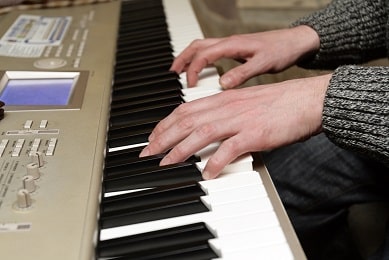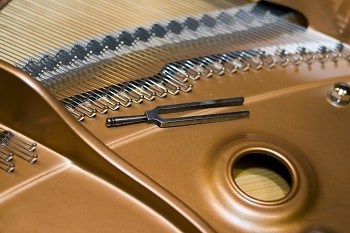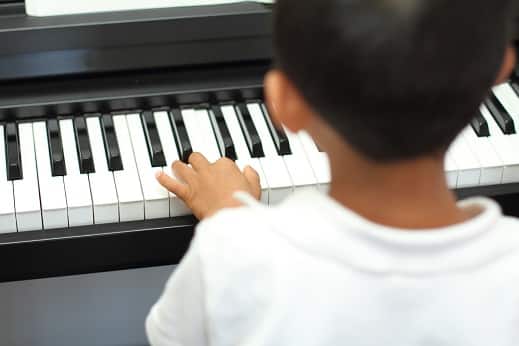As an Amazon Associate I earn from qualifying purchases.
I remember when I first started taking piano lessons at the age of 6. At the time I had an old Yamaha digital piano; the kind that can make 60 different sound effects! As a new piano student though my teacher was never happy about me using it.
She insisted that I switch to an acoustic piano. I didn’t understand it at the time, but an acoustic piano was going to be a major contributor to my future success as a pianist. While the financial investment was larger, the quality of my playing benefited greatly.
I think when it comes to pianos and trying to decide on a digital or acoustic, it usually comes down to cost and a few other factors. Below are 6 key differences between acoustic and digital pianos:
- Digital Pianos Are Cheaper
- Sound
- Acoustic Pianos Require Tuning
- The Feel of Digital Piano Keys vs Acoustic Keys
- Acoustic Pianos Are More Durable
- Portability and Size
By understanding all of these differences you can get a nice idea of whether a digital or acoustic piano is going to work for your household. For new pianists this information is really beneficial, so let’s hop right in!
Want to Learn Piano?Click Here

1. Digital Pianos Are Cheaper
The biggest positive of owning a digital piano as opposed to an acoustic one is that the costs are not as steep; check out some of the best digital pianos here to see what I mean. A solid digital piano like the Yamaha might cost around $90 – $100. Intermediate models that feature touch response hover in the $300 – $500.
The highest quality digital pianos are those that feature hammer action and give the best replication of what an acoustic piano could accomplish (although it’ll never completely replace an acoustic piano). I consider this Yamaha Smart Piano to be a good choice for the serious pianist.
Acoustic pianos, on the other hand, have a much higher entry point; typically two to three times that of a digital piano. The reason acoustic pianos cost so much is due to the craftsmanship and types of parts used. Everything from the woodworking down to the metal pins, soundboard, keyboard, and branding.
I find that there’s a great deal of difference between uprights and grand pianos when it comes to the pricing. A quality low-end grand piano might start around $10,000. A low end upright would start around $5000 – $6000.
For a beginning student the preference should always be a grand piano, but purchasing a quality upright piano can ensure the right kind of musical development. Yamaha and Baldwin make excellent upright pianos and if you’ve got a bit more wiggle room I would check out the low-end Steinway pianos as well.
My advice to you if decide to go with a digital piano is to not cheap out on it. If your goal is to effectively replace an acoustic piano then it’s advisable for you to spend somewhere between the $500 – $2000 range. This way you’re purchasing a piano that replicates what an acoustic can do without making the full dive.
2. Sound and Features
Digital pianos have a lot of appeal because of their range of sound effects. Depending on the grade of the instrument, some even let you add in sounds via computer or USB connection. For kids, this is a nice feature because it adds a level of intrigue to their piano playing.
Instead of just a piano sound, they can switch between brass instruments, strings, percussion and even cool sound effects. As a teacher, these pianos are fun to work with because they contain other features like metronomes, digital assistants, play-along accompaniments, transposition and more.
Acoustic pianos might not offer a variety of sounds, but they do offer the purest piano sound one can hope to achieve. Rather than a midi sound sample, you’re presented with the real thing. The sound is produced from a real soundboard with copper strings, hammers, dampers, pedals and the instruments wood casing.
Digital pianos attempt to reproduce those sounds, however, there’s always going to be that desire for a more natural presentation. An investment in something like this Yamaha keyboard would give the be the best comparison to an acoustic piano.
3. Acoustic Pianos Require Tuning

I’ve owned both digital and acoustic pianos, so I can vouch for this next talking point. Tuning is something that simply has to be done. Whether it’s a grand piano or an upright, every 6 months or so this procedure needs to be done.
Proper tuning helps your piano maintain it’s sound, prevent damage related to loosened strings, and much more. Unfortunately tuning a piano costs around $150 – $200 each time it’s done, and a big reason some of us choose digital instead.
Digital pianos don’t require any sort of tuning since it’s all computerized. In fact, you can change the tuning to any pitch you want via modulation controls. At most you might have to purchase new batteries, blow dust out of the keys and replace cables and pedals; all very small costs.
4. The Feel of Digital Piano Keys vs Acoustic Keys

The touch and feel of pianos are really important; especially in performance and practice. Outside of price, this is where digital and acoustic pianos have the biggest separation. Digital pianos are known for their extremely light key action. They almost feel weightless, so as a result pianists can play extremely fast on them with little effort.
That might seem great on the surface, but dig deeper and it presents a tough situation when transitioning to an acoustic instrument. This is because some weighted and semi-weighted digital pianos use a spring mechanism for key resistance.
Digital pianos with hammer action, however, do a much better job at replicating an acoustic piano. These digital pianos have a lever mechanism and small hammer built-in so that you can get the feeling of natural weight and resistance. Ultimately a pianist needs to have a good hammer feel to be as expressive as possible.
5. Acoustic Pianos Are More Fragile
Digital pianos are low cost and are quite durable. Outside of a water spill, there’s a very low chance that a digital piano would experience severe damage. Because of how they’re built, all of the important electrical components are concealed inside the plastic frame of the instrument.
Something durable like the Yamaha Smart Piano or Clavinova would be an excellent choice. It sits from that ground up and doesn’t require any sort of keyboard stand to maintain it’s position. I actually advocate against getting a digital piano that needs a keyboard stand in order to be used. This is because the likelihood of a child knocking it over is quite high. Floor standing digital pianos are the best way to go.
In contrast, acoustic pianos are known for their thick wooden frames that can withstand a couple of dings and scratches over time. They are floor standing, have keyboard covers built-in as well as detachable music stands. Despite weighing hundreds of pounds and built with tremendous care, acoustic pianos are quite fragile to outside elements.
Things like extreme shifts in temperature, dust buildup, water and more can be extremely damaging to the instrument. There are more delicate parts to be concerned about such as the soundboard, strings, hammers, and metal pins.
Since acoustic pianos deal with natural wood and metals, it’s important to keep the humidity levels in the home at a reasonable level. When the humidity rises it’s easy for the wood to swell, parts to loosen and fall out of place and much more.
6. Portability and Size
If you’re a parent with a new piano student, then chances are size and portability are on your mind. I own three pianos (2 uprights and one grand) and there’s no doubt size plays a major factor. I started off with two upright pianos not just because of their cost, but because of the amount of room it allowed for in our home at the time.
Upright acoustic pianos average around 5 feet in length and stand 4 feet off of the ground. They are easy to position against flat walls or in the middle of a room too. On the flip side, a ground piano presents a much more challenging situation.

Grand pianos should always be on an inside wall, mostly due to helping them maintain their tuning. For that reason, these pianos should be in the middle of a room. Grand pianos are much larger than uprights and they position horizontally rather than vertically.
They are also much heavier in weight compared to uprights, so moving them around usually requires help. Because of their size and delicacy grand pianos typically require a professional moving team whenever you need to transition them from one location to another.
While both upright and grand pianos offer their moving challenges, the same simply can’t be said for digital pianos. These pianos are lightweight, smaller in overall size and can be moved around to any location that has a wall outlet. In many cases, a digital piano can be stored away in a carrying case or even slid under a bed or propped up in a closet.
Digital pianos are excellent choices for those who plan to move the instrument around often. It’s an instrument you could pack up into a car and take on vacation with you; something you just can’t do with an acoustic piano. For that reason, digital pianos are really appealing to most families, especially those who are tight on space and need a quick solution.
Deciding Which Type Of Piano To Purchase
Making the decision to purchase a piano of any sort is always tough. There are recommendations all over the place. The piano dealer, of course, would want to convince you to purchase an acoustic piano, quite possibly a grand. However, that might not be the most cost-effective option for everyone.
Before purchasing any kind of piano I would factor in all of the points made in this article.
Price Matters
Remember that when it comes to cost there’s not much of a debate there. Digital pianos are cheaper across the board. The entry point can be as low as $100 and extend well beyond $1000.
The more you invest in a digital piano, the closer you get to a realistic playing experience. With lower prices comes fewer features, sounds, responsive action, and durability. Acoustic pianos might cost more, but it’s the best way for new pianists to develop their skills.
Real Action Vs Synthetic Action
If a student were to practice exclusively on a digital piano that did not have hammer action, they would most certainly struggle when trying to give a public performance on a real piano. Keeping that in mind there’s almost no reason to choose a model that doesn’t have hammer action.
Real hammer action cannot be replaced, but a digital keyboard can get you by for a couple of years. As pianists develop they’re going to want an upgrade, in which I would suggest going with an acoustic upright.
With more music study and advancement there will certainly be the need for a grand piano as well. It’s perfectly fine to purchase instruments and upgrade as the student improves.
Thinking Of Future Costs
The next thing you should consider is the overall maintenance costs of acoustic pianos. Tuning the instrument twice a year will cost around $300 – $400, something some new piano owners need to be comfortable with.
In addition to that if an acoustic piano is ever in need of serious repairs then that can run in the thousands of dollars range. Things like pad replacements, restoration, and water damage just to name a few things. With proper care, all of that can be avoided though.
While digital pianos have low maintenance costs, they should still be taken care of. If they suffer enough severe drops or have internal mechanical failures you’ll have to just purchase a brand new one. It would be wise to make use of a quality piano carrying case
Keeping Your Options Open
My last bit of advice to you would be to simply keep your options open. Acoustic pianos can be acquired both new or used, so finding a bargain is quite common. Think about asking your friends and family if they have any instruments they would be willing to let you have.
Likewise with digital pianos you can find used models for quite a bargain. The wear and tear on used models are much less noticeable than on an acoustic instrument. Buying new is always my preference on any piano, but this is an option worth pursuing.
Hello & thanks for stopping by! I’m a professional concert pianist and piano instructor. In the United States, I’ve given successful performances in several places including New York, Florida, Connecticut, & New Jersey, I have also performed internationally in Italy and made my Carnegie Hall debut in 2014. I enjoy blogging about the piano, the art of performance, general music, current events and the latest in music production.

How Long To Practice Piano - Joshua Ross
Wednesday 9th of January 2019
[…] On A Keyboard? Yes, you can learn how to play the piano on a keyboard. The keyboard should feature hammer action or weighted keys to help simulate what a real acoustic piano can do. Learning on a keyboard can potentially slow […]
How To Buy A Piano - The Complete Guide - Joshua Ross
Wednesday 12th of September 2018
[…] I would consider the upright piano to be the median choice. It has a much lower investment point than a grand piano but still offers an authentic touch that keyboards often try to replicate. The average upright piano costs between $5000 – $6000. […]
Difference Between Hammer Action And Weighted Keys - Joshua Ross
Wednesday 5th of September 2018
[…] might seem terrible, but considering an upright piano average between $5000-$6000, the price is a mere fraction of that for a digital piano. Other things that contribute to some […]